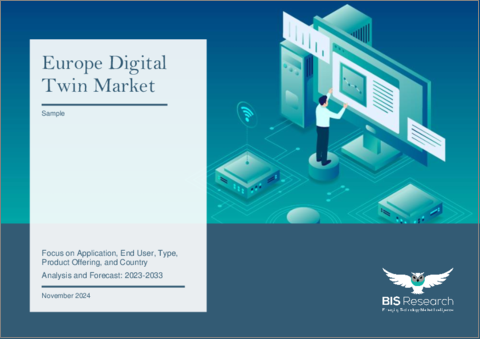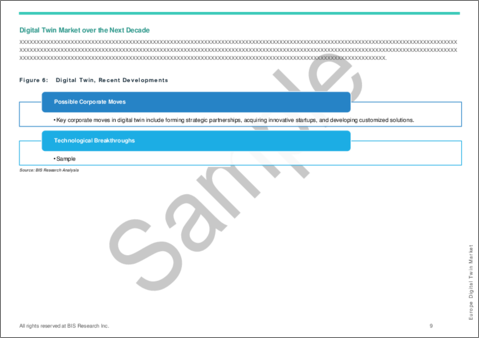|
|
市場調査レポート
商品コード
1594217
欧州のデジタルツイン市場:用途別、エンドユーザー別、タイプ別、製品タイプ別、国別 - 分析と予測(2023年~2033年)Europe Digital Twin Market: Focus on Application, End User, Type, Product Offering, and Country - Analysis and Forecast, 2023-2033 |
||||||
カスタマイズ可能
|
|||||||
| 欧州のデジタルツイン市場:用途別、エンドユーザー別、タイプ別、製品タイプ別、国別 - 分析と予測(2023年~2033年) |
|
出版日: 2024年11月21日
発行: BIS Research
ページ情報: 英文 62 Pages
納期: 1~5営業日
|
- 全表示
- 概要
- 図表
- 目次
欧州のデジタルツインの市場規模は、2023年の30億米ドルから2033年には2,975億米ドルに達し、予測期間の2023年~2033年のCAGRは58.55%になると予測されています。
デジタルツインは、現実世界の物体、システム、プロセスを模倣した仮想モデルであり、欧州では業務改善やイノベーションを促進するために一般的に使用されています。製造、ヘルスケア、都市計画などの分野におけるリアルタイムシミュレーションは、IoT、AI、機械学習、ビッグデータを組み合わせたデジタルツインによって可能になります。物理的な物体からセンサーデータを収集することで、意思決定を改善し、予測的な洞察を提供し、手続きを迅速化します。デジタルツインは、ライフサイクル管理やメンテナンスの最適化など、さまざまな分野における効率化とイノベーションへの欧州のアプローチに革命をもたらしています。
| 主要市場統計 | |
|---|---|
| 予測期間 | 2023年~2033年 |
| 2023年の評価 | 30億米ドル |
| 2033年の予測 | 2,975億米ドル |
| CAGR | 58.55% |
モノのインターネット(IoT)、人工知能(AI)、ビッグデータ分析などの最先端技術の利用拡大が、欧州のデジタルツイン市場の目覚ましい拡大を後押ししています。現実世界のシステム、プロセス、モノの仮想版を作り出すデジタルツインは、欧州のさまざまな企業でイノベーションの重要な要素として浮上しています。デジタルツインはリアルタイムのシミュレーションと予測分析を提供し、意思決定、オペレーションの最適化、システムや商品のライフサイクルにわたる効率向上を支援します。
欧州全体でインダストリー4.0、スマートシティ、持続可能な市場開拓プロジェクトが重視されるようになっていることが、市場の成長を後押ししています。デジタルツインは、製造業、ヘルスケア、エネルギー、都市計画などの産業で、業務効率の向上、経費削減、環境への悪影響の軽減のために利用されています。デジタルツインが予知保全、サプライチェーン管理、インフラ整備に組み込まれることで、その多様な用途が浮き彫りになります。
市場の主要企業は、欧州のさまざまな分野に適した最先端のデジタルツインソリューションを提供するため、研究開発に多額の投資を行っています。この画期的な技術の採用を促進するため、政府と企業グループはますます協力しています。欧州は依然として持続可能性と技術革新の最前線にあり、デジタルツイン市場は着実に成長し、分野を変え、よりインテリジェントな意思決定を促進すると予想されます。
当レポートでは、欧州のデジタルツイン市場について調査し、市場の概要とともに、用途別、エンドユーザー別、タイプ別、製品タイプ別、国別の動向、および市場に参入する企業のプロファイルなどを提供しています。
目次
エグゼクティブサマリー
第1章 市場
- 動向:現在および将来の影響評価
- エコシステム/進行中のプログラム
- インダストリー5.0におけるデジタルツインの役割
- 業界別のユースケース
- スタートアップ資金調達の概要
- 市場力学の概要
- サプライチェーンの概要
第2章 地域
- 地域別概要
- 欧州
第3章 市場-競合ベンチマーキングと企業プロファイル
- 今後の見通し
- 地理的評価
- ABB
- Dassault Systemes
- Robert Bosch Gmbh
- Siemens
- SAP SE
第4章 調査手法
List of Figures
- Figure 1: Digital Twin Market (by Region), $Billion, 2022, 2023, and 2033
- Figure 2: Europe Digital Twin Market (by Application), $Billion, 2022, 2023, and 2033
- Figure 3: Europe Digital Twin Market (by End User), $Billion, 2022, 2023, and 2033
- Figure 4: Europe Digital Twin Market (by Product Offering), $Billion, 2022, 2023, and 2033
- Figure 5: Europe Digital Twin Market (by Type), $Billion, 2022, 2023, and 2033
- Figure 6: Digital Twin, Recent Developments
- Figure 7: Impact Analysis of Market Navigating Factors, 2022-2033
- Figure 8: Supply Chain and Risks within the Supply Chain
- Figure 9: France Digital Twin Market, $Billion, 2022-2033
- Figure 10: Germany Digital Twin Market, $Billion, 2022-2033
- Figure 11: U.K. Digital Twin Market, $Billion, 2022-2033
- Figure 12: Russia Digital Twin Market, $Billion, 2022-2033
- Figure 13: Rest-of-Europe Digital Twin Market, $Billion, 2022-2033
- Figure 14: Strategic Initiatives, 2020-2023
- Figure 15: Share of Strategic Initiatives, 2020-2023
- Figure 16: Data Triangulation
- Figure 17: Top-Down and Bottom-Up Approach
- Figure 18: Assumptions and Limitations
List of Tables
- Table 1: Market Snapshot
- Table 2: Digital Twin Market, Opportunities across Regions
- Table 3: Funding and Investment Scenario, February 2022-February 2024
- Table 4: Digital Twin Market (by Region), $Billion, 2022-2033
- Table 5: Europe Digital Twin Market (by End User), $Billion, 2022-2033
- Table 6: Europe Digital Twin Market (by Application), $Billion, 2022-2033
- Table 7: Europe Digital Twin Market (by Type), $Billion, 2022-2033
- Table 8: Europe Digital Twin Market (by Product Offering), $Billion, 2022-2033
- Table 9: France Digital Twin Market (by End User), $Billion, 2022-2033
- Table 10: France Digital Twin Market (by Application), $Billion, 2022-2033
- Table 11: France Digital Twin Market (by Type), $Billion, 2022-2033
- Table 12: France Digital Twin Market (by Product Offering), $Billion, 2022-2033
- Table 13: Germany Digital Twin Market (by End User), $Billion, 2022-2033
- Table 14: Germany Digital Twin Market (by Application), $Billion, 2022-2033
- Table 15: Germany Digital Twin Market (by Type), $Billion, 2022-2033
- Table 16: Germany Digital Twin Market (by Product Offering), $Billion, 2022-2033
- Table 17: U.K. Digital Twin Market (by End User), $Billion, 2022-2033
- Table 18: U.K. Digital Twin Market (by Application), $Billion, 2022-2033
- Table 19: U.K. Digital Twin Market (by Type), $Billion, 2022-2033
- Table 20: U.K. Digital Twin Market (by Product Offering), $Billion, 2022-2033
- Table 21: Russia Digital Twin Market (by End User), $Billion, 2022-2033
- Table 22: Russia Digital Twin Market (by Application), $Billion, 2022-2033
- Table 23: Russia Digital Twin Market (by Type), $Billion, 2022-2033
- Table 24: Russia Digital Twin Market (by Product Offering), $Billion, 2022-2033
- Table 25: Rest-of-Europe Digital Twin Market (by End User), $Billion, 2022-2033
- Table 26: Rest-of-Europe Digital Twin Market (by Application), $Billion, 2022-2033
- Table 27: Rest-of-Europe Digital Twin Market (by Type), $Billion, 2022-2033
- Table 28: Rest-of-Europe Digital Twin Market (by Product Offering), $Billion, 2022-2033
- Table 29: Market Share, 2022
Introduction to Europe Digital Twin Market
The Europe digital twin market is projected to reach $297.5 billion by 2033 from $3.0 billion in 2023, growing at a CAGR of 58.55% during the forecast period 2023-2033. Digital twins, which are virtual models that mimic real-world objects, systems, or processes, are commonly used in Europe to improve operations and spur innovation. Real-time simulations for sectors like manufacturing, healthcare, and urban planning are made possible by digital twins, which combine IoT, AI, machine learning, and big data. They improve decision-making, provide predictive insights, and expedite procedures by collecting sensor data from physical objects. Digital twins are revolutionizing Europe's approach to efficiency and innovation in a variety of areas, including lifecycle management and maintenance optimization.
Market Introduction
| KEY MARKET STATISTICS | |
|---|---|
| Forecast Period | 2023 - 2033 |
| 2023 Evaluation | $3.0 Billion |
| 2033 Forecast | $297.5 Billion |
| CAGR | 58.55% |
The growing use of cutting-edge technologies like the Internet of Things (IoT), artificial intelligence (AI), and big data analytics has propelled the impressive expansion of the European digital twin market. Digital twins, which produce virtual versions of real-world systems, processes, or things, have emerged as a key component of innovation in a variety of European businesses. Digital twins provide real-time simulations and predictive analytics, which aid in decision-making, operations optimization, and efficiency enhancement over the lifecycle of systems or goods.
The increasing emphasis on Industry 4.0, smart cities, and sustainable development projects throughout Europe is driving the market's growth. Digital twins are being used by industries like manufacturing, healthcare, energy, and urban planning to increase operational effectiveness, cut expenses, and lessen their negative effects on the environment. Digital twins' incorporation in predictive maintenance, supply chain management, and infrastructure development highlights their versatile applications.
Leading companies in the market are making significant investments in R&D to provide cutting-edge digital twin solutions that are suited to the various sectors in Europe. To encourage the adoption of this game-changing technology, governments and business groups are working together more and more. With Europe still at the forefront of sustainability and technical innovation, the digital twin market is expected to rise steadily, changing sectors and facilitating more intelligent decision-making.
Market Segmentation:
Segmentation 1: by Application
- Product Design Development
- Performance Monitoring
- Predictive Maintenance
- Inventory Management
- Others
Segmentation 2: by End User
- Manufacturing
- Automotive
- Aviation
- Energy and Utilities
- Healthcare
- Logistics and Retail
- Others
Segmentation 3: by Type
- Asset Digital Twin
- Process Digital Twin
- System Digital Twin
- Digital Twin of an Organization (DTO)
Segmentation 4: by Product Offering
- Platforms
- Hardware
- Support Services
Segmentation 5: by Country
- U.K.
- Germany
- France
- Russia
- Rest-of-the-Europe
How can this report add value to an organization?
Product/Innovation Strategy: The product segment helps the reader understand the different types of products available for deployment in Europe Region. Moreover, the study provides the reader with a detailed understanding of the Europe digital twin market based on application (product design development, performance monitoring, predictive maintenance, inventory management, and others), and by end user (manufacturing, automotive, aviation, energy and utilities, healthcare, logistics and retail, and others), on the basis product offering (platform, hardware, and software service), and by type (Asset Digital Twin, Process Digital Twin, System Digital Twin, and Digital Twin of an Organization (DTO).
Growth/Marketing Strategy: The Europe digital twin market has seen major development by key players operating in the market, such as business expansion, partnership, collaboration, and joint venture. The favored strategy for the companies has been partnerships and contracts to strengthen their position in the Europe digital twin market.
Key Market Players and Competition Synopsis
The companies that are profiled have been selected based on thorough secondary research, which includes analyzing company coverage, product portfolio, market penetration, and insights gathered from primary experts.
Some prominent names established in this market are:
- ABB Ltd.
- Dassault Systemes
- Robert Bosch GMBH
Table of Contents
Executive Summary
Scope and Definition
1 Markets
- 1.1 Trends: Current and Future Impact Assessment
- 1.1.1 Rise of Digital Twins in Infrastructure Development
- 1.1.2 Hyper-Personalization
- 1.2 Ecosystem/Ongoing Programs
- 1.2.1 Project PLATEAU
- 1.3 Role of Digital Twin in Industry 5.0
- 1.4 Use Cases by Industry
- 1.5 Startup Funding Summary
- 1.6 Market Dynamics Overview
- 1.6.1 Market Drivers
- 1.6.1.1 Increasing Adoption of AI, ML, IoT, Data Analytics, and 5G
- 1.6.1.2 Increasing Investment in Digital Twin City
- 1.6.2 Market Restraints
- 1.6.2.1 Technical Hurdles in Digital Twin Implementation
- 1.6.2.2 Scaling and High Fidelity
- 1.6.3 Market Opportunities
- 1.6.3.1 Increasing Use of Digital Twin across Various Industries
- 1.6.1 Market Drivers
- 1.7 Supply Chain Overview
2 Regions
- 2.1 Regional Summary
- 2.2 Europe
- 2.2.1 Regional Overview
- 2.2.2 Driving Factors for Market Growth
- 2.2.3 Factors Challenging the Market
- 2.2.4 Application
- 2.2.5 Product
- 2.2.6 France
- 2.2.7 Application
- 2.2.8 Product
- 2.2.9 Germany
- 2.2.10 Application
- 2.2.11 Product
- 2.2.12 U.K.
- 2.2.13 Application
- 2.2.14 Product
- 2.2.15 Russia
- 2.2.16 Application
- 2.2.17 Product
- 2.2.18 Rest-of-Europe
- 2.2.19 Application
- 2.2.20 Product
3 Markets - Competitive Benchmarking & Company Profiles
- 3.1 Next Frontiers
- 3.2 Geographic Assessment
- 3.2.1 ABB
- 3.2.1.1 Overview
- 3.2.1.2 Top Products/Product Portfolio
- 3.2.1.3 Top Competitors
- 3.2.1.4 Target Customers
- 3.2.1.5 Key Personnel
- 3.2.1.6 Analyst View
- 3.2.1.7 Market Share, 2023
- 3.2.2 Dassault Systemes
- 3.2.2.1 Overview
- 3.2.2.2 Top Products/Product Portfolio
- 3.2.2.3 Top Competitors
- 3.2.2.4 Target Customers
- 3.2.2.5 Key Personnel
- 3.2.2.6 Analyst View
- 3.2.2.7 Market Share, 2023
- 3.2.3 Robert Bosch Gmbh
- 3.2.3.1 Overview
- 3.2.3.2 Top Products/Product Portfolio
- 3.2.3.3 Top Competitors
- 3.2.3.4 Target Customers
- 3.2.3.5 Key Personnel
- 3.2.3.6 Analyst View
- 3.2.3.7 Market Share, 2023
- 3.2.4 Siemens
- 3.2.4.1 Overview
- 3.2.4.2 Top Products/Product Portfolio
- 3.2.4.3 Top Competitors
- 3.2.4.4 Target Customers
- 3.2.4.5 Key Personnel
- 3.2.4.6 Analyst View
- 3.2.4.7 Market Share, 2023
- 3.2.5 SAP SE
- 3.2.5.1 Overview
- 3.2.5.2 Top Products/Product Portfolio
- 3.2.5.3 Top Competitors
- 3.2.5.4 Target Customers
- 3.2.5.5 Key Personnel
- 3.2.5.6 Analyst View
- 3.2.5.7 Market Share, 2023
- 3.2.1 ABB
4 Research Methodology
- 4.1 Data Sources
- 4.1.1 Primary Data Sources
- 4.1.2 Secondary Data Sources
- 4.1.3 Data Triangulation
- 4.2 Market Estimation and Forecast






